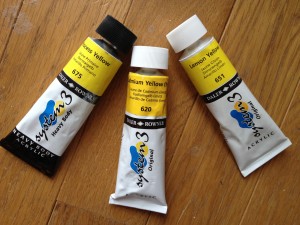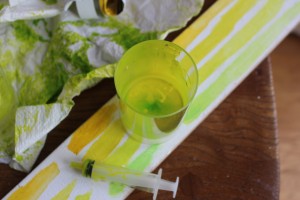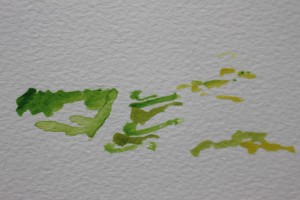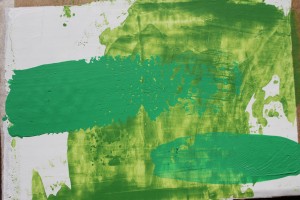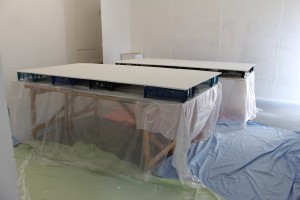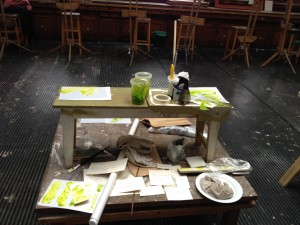Materials and Methods
The selection of materials and the processes to be employed in preparing and painting the triptych, were paramount. They were to represent the solidity of the landscape, the clarity and breadth of light, the zest of colour and the exuberance experienced during an event of colour travelling across the landscape. Having trialled a range of commercially produced and self-made substrates (with differing surface textures), it was decided to represent the painting on boards of polished gesso. The pigment (as coloured light), would be applied using the simplest of physical gestures, a ‘swipe’. This would be executed at different paces and different degrees of pressure, reminiscent of the manner in which the colour moved across the fileds. Three paintings would be produced in an attempt to present a colour event on a dry day, a day of particularly high humidity and a day of changing levels of humidity.
Colour Preparation
Devising the required shades of green which would bleed into yellows and achieving the necessary spatter and watery effects, required experimentation a good and consistent light source.
The mode of paint application required especially careful consideration, as it needed to demonstrate the manner in which the colours moved across the fields. The movement might be a rush, a flow or slow infiltration. As the pace altered, so did the qualities of the colour. There were delicate, dipping, brush strokes of colour, minutely detailed, but also robust, brash and assertive waves of pigment, appearing to envelop the whole hillside.
Experimenting with different ways of expressing the movement of colour, included: trailing, spattering, throwing, spreading and dripping water, mixed emulsions and paint.
Board Preparation
Following a light sanding, knots were sealed.
Early gesso coats did not always obscure flaws.
Dried gesso was polished, each board requiring approximately ten hours. This was very messy, physically demanding and required some assistance.
Working with three wood-ply boards (measuring 8′ x 4′ and sourced from the same supplier), proved to be a different experience in each case. The process was more successful in some areas than in others – the cause of much frustration.
When ready, the surface shone with reflected light.
Despite the careful sealing of knots and other aberrations, shadows could still be apparent through several coats of gesso in some areas. This was obviously problematic for paintings which required a pure white background.
Preparing to Paint
Painting on such a large scale required plenty of space.
Studio 301 at the School of Art, Aberystwyth University was the perfect place in which to work. Brushes were replaced with a specially prepared baton. 
Keeping sufficiently calm to apply the pigment in the planned and practised manner, was challenging. There was after all only one opportunity to paint each board. Miranda captured those events as they happened.
The results are the triptych, ‘Pendinas, Golau Haf … Summer Light’.
The first painting became the right hand board of the triptych. The gesture, the ‘swipe’ is recorded here.
The middle board was a pleasure to paint.

